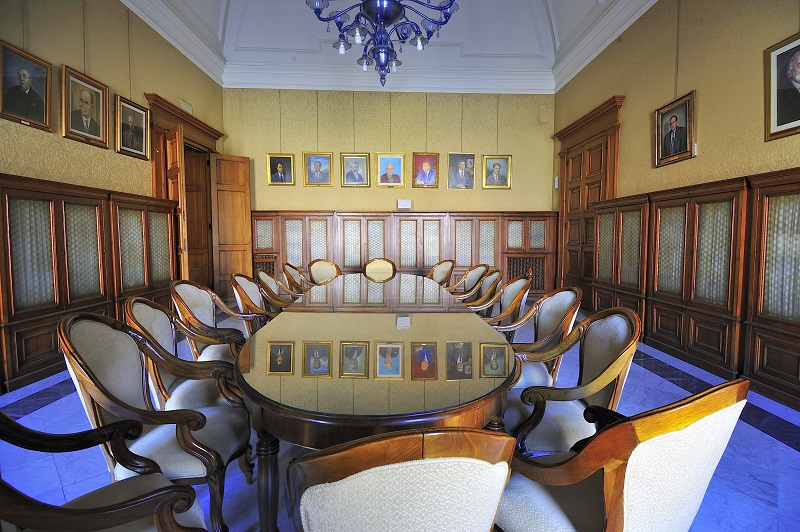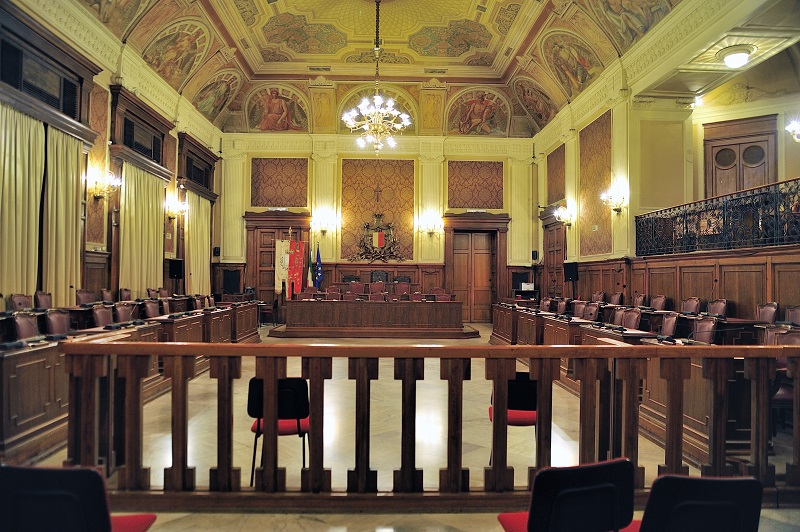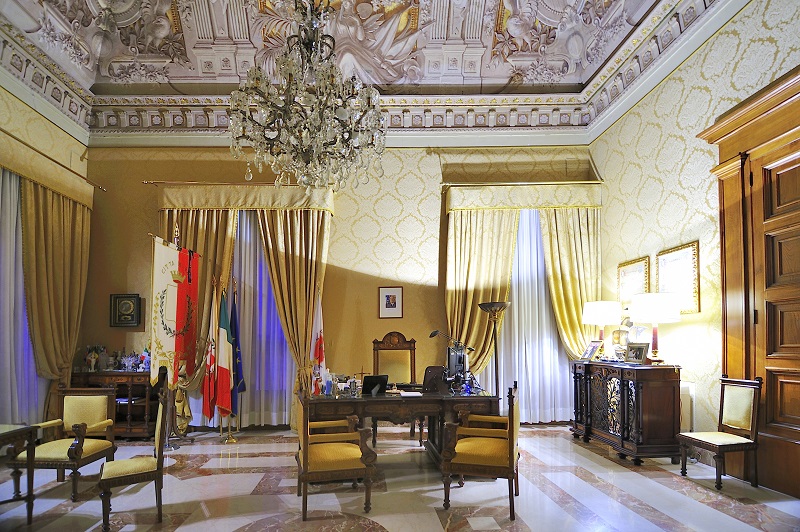Palazzo di Città
Palazzo di Città
Quello che oggi è il Palazzo di Città si presenta a tutti gli effetti come un corpo di fabbrica che “incornicia” il Teatro Piccinni ed occupa l’isolato ricompreso fra corso Vittorio Emanuele, via Roberto da Bari, via Piccinni e via Cairoli. L’aspetto architettonico complessivo dell’edificio, tuttavia, è stato per lungo tempo molto diverso da quello attuale.
Dapprima fu completato il teatro, inaugurato nel 1854, dopo 14 anni dall’avvio dei lavori e numerose modifiche al progetto originario dell’architetto Antonio Niccolini.
Degli spazi rimasti vuoti ai lati del teatro si tornò a parlare nel 1859, quando a Bari arrivò il re Ferdinando II di Borbone per accogliere la principessa Maria Sofia Amalia di Baviera. In quell’occasione, il re diede disposizioni per la riapertura di un cantiere nel terreno sul lato orientale, ma la conquista del Regno delle Due Sicilie da parte delle truppe piemontesi e il processo di unificazione della penisola nel Regno d’Italia ne rallentarono i lavori.
Fu solo nel 1863 che l’area dell’edificio in corso Vittorio Emanuele ad angolo con via Roberto da Bari divenne sede del Municipio. Prima di allora, infatti, il governo barese aveva conosciuto altre due collocazioni nel Borgo Antico: dapprima nel Palazzo del Sedile, in piazza Mercantile, quindi in un edificio ubicato in quella che ancora oggi è denominata ‘Strada Palazzo di Città’. Il 21 luglio 1864 il Consiglio Comunale poté per la prima volta tenersi nella nuova sede.
Nel 1867 si avviò la costruzione dell’ala opposta destinata a ospitare invece il Palazzo di Giustizia.
All’inizio del ‘900 fu aggiunto un secondo piano per far spazio al Sindaco e ai suoi funzionari e per uniformare il corpo di fabbrica orientale del Teatro con quello a occidente. I lavori terminarono definitivamente nel 1915.
Dopo essere stata sede del Palazzo di Giustizia, l’ala dell’edificio in cui attualmente vi trovate, ospitò il liceo ginnasio Domenico Cirillo e solo nel 1933, fu adibita a nuovi uffici comunali.
Le Sale di rappresentanza del Palazzo di Città sono di rilevante levatura artistica. In particolare, il Gabinetto del Sindaco, la cui volta affrescata dal pittore Nicola Colonna risale ai primi del ‘900. Vi sono raffigurati dei puttini che sostengono lo stemma della città adornato con i prodotti tipici del territorio. Sulla volta sono visibili anche il vecchio ed il nuovo simbolo della Città. Ai quattro lati del soffitto sono invece raffigurate le allegorie dei quattro continenti: Europa, Asia, Africa e America. Alla parete una copia del dipinto dell’artista francese François Gérard, eseguita dal pittore Leonardo Minervini e raffigurante il re Gioacchino Murat. Di particolare pregio è la scrivania del Sindaco, di autore sconosciuto, finemente intagliata con gli stemmi del Comune e le sagome della Cattedrale e del monumento a Piccinni.
La sala antistante il Gabinetto del Sindaco è intitolata a Giuseppe Massari, primo Deputato di Bari al Parlamento nazionale dopo l'Unità d'Italia. Il suo busto marmoreo su piedistallo, opera dello scultore romano Emilio Tadolini è lì esposto insieme ad altre opere scultoree raffiguranti i Sindaci di Bari Giuseppe Re David, dello scultore molfettese Filippo Cifariello e Renato Dell'Andro, dello scultore Mario Colonna. Alle pareti della sala, si possono ammirare i ritratti ad olio di illustri cittadini baresi.
Dalla Sala Massari si accede alla Sala Giunta, dove spicca un imponente tavolo ovale per gli incontri istituzionali, sovrastato da uno splendido lampadario di Murano. Gli arredi sono arricchiti da una preziosa consolle del settecento e una specchiera della stessa epoca, intagliata a mano con decoro floreale. Sulle pareti della sala sono affissi i ritratti dei defunti sindaci di Bari e un’opera dell’artista albanese, Duli Caja, realizzata con 18.000 bottoni, quanti i profughi albanesi arrivati a bordo della nave Vlora nel 1991.
Al pittore veneziano Mario Prayer, negli anni ’30 fu invece affidata la decorazione della Sala Consiliare, successivamente dedicata al Sindaco Enrico Dalfino. L'artista effettuò la decorazione pittorica dividendo la volta in tre grandi scomparti, con rosoni centrali di stucco. L’affresco è impreziosito da 18 lunette allegoriche che rappresentano le arti, le scienze, le industrie, il commercio, l’agricoltura e le attività lavorative del territorio. La figura centrale rappresenta una matrona in trono, con la mano sinistra poggiata sullo scudo bianco rosso e la mano destra su un timone di nave a simboleggiare la città di Bari.
Il grande stemma del Comune che adorna la sala Dalfino, intagliato nel legno, fu realizzato nel 1877 dallo scultore barese Giuseppe Giannelli, autore anche degli scranni e della pedana d’aula. Sormontato da una corona a cinque torri, simbolo del titolo onorifico di Città, di cui Bari è stata insignita per il suo valore, reca uno scudo centrale diviso per metà nei colori bianco e rosso. Lo stemma è sostenuto da due rami laterali: a destra di alloro e a sinistra di quercia e legati insieme con un fiocco.
Dalla prefazione del volume di V. Melchiorre – Bari il Palazzo di Città (Ed. Adda 1997) da cui è liberamente tratta questa descrizione: “Fu quella della costruzione del teatro Piccinni e del Palazzo di Città, si può dire, l'epoca della rinascita di Bari; in quegli anni, infatti, furono realizzate altre importantissime opere di cui la città può tuttora fregiarsi in fierezza e rappresentatività, con le testimonianze architettoniche ed urbanistiche della ordinata maglia del Borgo Murattiano che, dall'800 a tutt'oggi, costituiscono appunto il fulcro nevralgico di attività istituzionali e private”.
The theatre was completed and inaugurated in 1854, 14 years after the start of construction. Furthermore, numerous modifications were made to the original design by the architect, Antonio Niccolini.
The empty wings on both sides of the theatre were discussed in 1859, when King Ferdinand II of Bourbon arrived in Bari to welcome Princess Maria Sophie Amalie of Bavaria. On that occasion, the king gave instructions for the reopening of a construction site on the eastern side of the theatre. Nevertheless, the conquest of the Kingdom of the Two Sicilies by the Savoy troops and the process of unification of the Kingdom of Italy slowed down construction.
In 1863, the part of the building located on Corso Vittorio Emanuele at the corner of Via Roberto da Bari finally became the City Hall. Previously, the government of Bari had been located in two other locations in the Borgo Antico: first in the Palazzo del Sedile, in Piazza Mercantile, then in a building located in an alley that is still called Strada Palazzo di Città. On 21 July 1864, the City Council held its first institutional meeting at the new site.
In 1867, the construction of the opposite wing was started. This section would eventually house the Palace of Justice.
At the beginning of the 1900s, a second floor for the Mayor and his officials’ rooms was added to the original building, thus making the eastern part of the theatre uniform with the western section. Work on the project finally ended in 1915.
After having been the site of the Palace of Justice, the wing of the building located in Via Cairoli housed Domenico Cirillo High School up until 1933. Later, it was used as new municipal offices.
The institutional rooms of Palazzo di Città have a relevant artistic value. In particular, the early 1900s vault of the Mayor's Cabinet was frescoed by the painter Nicola Colonna. It depicts cherubs supporting Bari's coat of arms, adorned with typical local products. Both the old and new symbols of the city are painted on the vault, along with allegorical depictions of four continents (Europe, Asia, Africa, and America) on the four sides of the ceiling. On the wall of the Cabinet, there is a copy by Leonardo Minervini of the painting by the French artist François Gérard, which represents King Joachim Murat. Finally, the precious Mayor's desk, created by an unknown author, is finely carved with the Bari coat of arms along with two silhouettes representing St. Sabino’s Cathedral and Piccinni’s monument.
The room in front of the Mayor's Cabinet is named after Giuseppe Massari, the first Deputy of Bari to the national Parliament after the unification of Italy. His marble bust, carved by the Roman sculptor Emilio Tadolini, is atop a pedestal and exhibited along with other sculptural works representing the Mayor Giuseppe Re David (by sculptor Filippo Cifariello) and Mayor Renato Dell'Andro (by sculptor Mario Colonna). On the walls of the room, you can admire the oil portraits of important citizens of Bari.
By passing through the Massari Room, you can reach thе Giunta Chamber, where the municipal administrators meet. There, a splendid Murano chandelier hangs over a wide, oval table used for institutional meetings. A precious 18th-century console and hand-carved mirror with floral decorations enrich and complete the furnishings. On the walls of the room, you can admire the portraits of Bari's previous mayors and a handcrafted work by the Albanian artist, Duli Caja, made with 18,000 buttons, as many as the Albanian refugees who arrived aboard the Vlora ship in 1991.
In the 1930s, the Venetian painter Mario Prayer was commissioned to decorate the City Council Chamber, later named for Mayor Enrico Dalfino. The artist painted the vault after dividing it into three large compartments with central stucco rosettes. The fresco is embellished with 18 allegorical lunettes representing arts, sciences, industries, commerce, agriculture, and the working activities of the area. The central figure represents an enthroned matron, whose left hand rests upon a red and white shield, while her right hand rests upon a ship's rudder symbolizing the city of Bari.
The large, wooden Bari coat of arms, adorning the Dalfino Chamber, was carved in 1877 by the local sculptor Giuseppe Giannelli, who also designed the benches and platform of the Council Chamber. It depicts a central white and red shield surmounted by a five-tower crown, the symbol of the honorific title of “city”, which Bari earned for its value. The coat of arms is supported by two lateral branches: a laurel to the right side and an oak to the left tied together by a bow.
The following description is freely taken from the preface of a volume by V. Melchiorre – Bari il Palazzo di Città (Ed. Adda 1997): “It can be said that the years of the Piccinni theatre and new City Hall construction represent an era of rebirth in Bari; in those years, in fact, several very important buildings were carried out and still represent the pride of the city. From the 19th century to the present day, they are the architectural and urbanistic witnesses of Borgo Murattiano’s orderly mesh, which can be considered the nerve centre of institutional and private activities.”
Обрамляющее Театр Пиччинни здание Мэрии города Бари расположено в квартале на пересечении между корсо Витторио Эмануэле, виа Роберто да Бари, виа Пиччинни и виа Кайроли. Однако, общий архитектурный облик здания долгое время сильно отличался от нынешнего.
Первым было завершено здание Театра. Открытие состоялось спустя 14 лет после начала строительства и после внесения многочисленных изменений в первоначальный проект архитектора Антонио Никколинии.
В 1859 году, когда король Фердинанд II Бурбон прибыл в Бари, чтобы принять принцессу Марию Софию Амелию Баварскую, был затронут вопрос о назначении пустых помещений, расположенных по обе стороны театра. Тогда король поручил возобновить строительство на восточной стороне театра, однако завоевание Королевства обеих Сицилий войсками Савойи и процесс объединения Италии значительно замедлили строительные работы.
Лишь в 1863 году помещение на пересечении корсо Витторио Эмануэле и виа Роберто да Бари стало зданием Мэрии города. Раньше барийская администрация была расположена в районе Бари Веккья (т.е. “Старый Бари”): сначала в Палаццо дель Седиле, на Пьяцца Меркантиле, затем в здании, расположенном на улице, которая до сих пор называется «Страда Палаццо Ди Читта» (т.е. “Улица Мэрии”). Первый городской совет в новом здании состоялся 21 июля 1864 года.
В 1867 году началось строительство противоположного крыла, предназначенного для размещения здания суда.
Затем, в начале XX века, был пристроен второй этаж, предназначенный для мэра и его сотрудников и выравнивающий восточное крыло с западным. Строительные работы были окончательно завершены в 1915 году.
После здания суда, в крыле, в котором вы сейчас находитесь, некоторое время располагалась гимназия им. Доменико Чирилло, а в качестве новых муниципальных офисов эту часть здания стали использовать лишь в 1933 году.
Парадные залы Мэрии имеют большую художественную ценность, особенно кабинет Мэра, чей свод, расписанный художником Никола Колонна, датируется началом ХХ века. На нем изображены путти, поддерживающие герб города, украшенный местными типичными продуктами. На своде также видны старый и новый символ города, а в углах потолка изображены аллегории четырех континентов: Европы, Азии, Африки и Америки. На одной из стен висит копия картины французского художника Франсуа Жерара, выполненная художником Леонардо Минервини и изображающая короля Иоахима Мюрата. Стол мэра представляет особую ценность: неизвестный художник украсил его тончайшей деревянной резьбой с изображением гербов города и силуэтов Собора Богоматери Одигитрия и памятника Пиччинни.
Зал, расположенный напротив кабинета мэра назван в честь Джузеппе Массари — первого депутата из Бари входящего в состав национального парламента после объединения Италии. Его мраморный бюст на пьедестале, выполненный римским скульптором Эмилио Тадолини, выставлен вместе с бюстами предыдущих глав города Бари Джузеппе Ре Давид (работы скульптора из Мольфетты Филиппо Чифариелло) и Ренато Делль'Андро (работы скульптора Марио Колонна), а на стенах зала вы увидите масляные портреты выдающихся граждан города Бари.
Перейдя из «Зала Массари» в «Зал Джунта», вы увидите внушительный овальный стол для официальных встреч и нависающую над ним великолепную люстру из муранского стекла. Обстановку дополняет изысканная консоль XVIII века и зеркало в резной раме с цветочным узором той же эпохи. На стенах зала размещены портреты покойных мэров города Бари и гобелен албанского художника Дули Цайа (Duli Caja), выполненный из 18 000 пуговиц – столько же, сколько беженцев прибыло в Бари на борту корабля Влора в 1991 году.
В 1930-х годах венецианскому художнику Марио Прайер была поручена роспись стен «Зала Городского Совета», который позже был назван в честь мэра Энрико Дальфино. Художник разделил потолок на три части, разместив в центре каждой из них лепную розетку. Фреска украшена 18 аллегорическими фигурами, обозначающими различные отрасли науки, промышленности, торговли, сельского хозяйства и промыслы территории. В центре изображена Матрона, сидящая на троне, которая левой рукой поддерживает красно-белый щит, а в правой руке держит штурвал – символ города Бари.
Большой деревянный гербовый щит, украшающий «Зал Дальфино», а также скамьи были изготовлены в 1877 году барийским скульптором Джузеппе Джаннелли. Над гербовым щитом размещена корона с пятью башнями – символ почетного титула города, которого Бари был удостоен за свою доблесть. Герб города представляет собой красно-белый щит между лавровой и дубовой ветвями, связанными лентой.
Данное описание является полной адаптацией книги В. Мелькьорре “Bari. Il Palazzo di Città” (Издательство Adda, 1997 г.). Из предисловия: «Время строительства театра Пиччинни и здания Мэрии было настоящей эпохой Возрождения города Бари. В самом деле, в те годы, были выполнены и другие важные работы, которыми город может гордиться по сей день, наряду со строгой архитектурной сетью квартала Мураттиано, которая с XIX века не перестает играть центральную роль и в институциональной и частной жизни города».

 comune
comune bari
bari Regione Puglia
Regione Puglia





